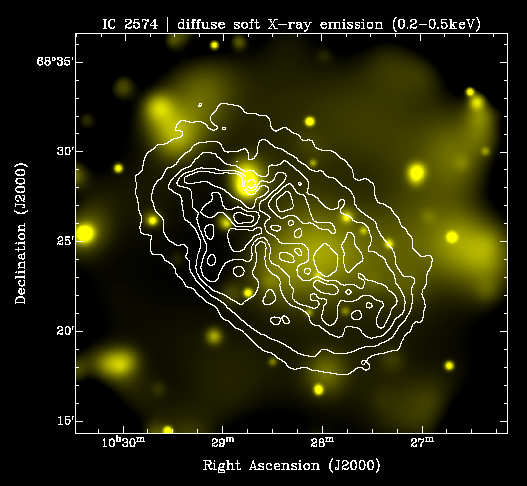

Diploma Theses
Dwarf Galaxies
Soft X-Ray Background
Radio Galaxies
Milky Way
Magellanic Clouds
High-Velocity Clouds
|
|
Dwarf GalaxiesThe interplay between the stellar population and the interstellar medium (ISM) is of fundamental astrophysical interest. Stars are born within the densest parts of the ISM. Because of stellar winds and supernova explosions, stars enrich their neighbourhood with processed material. Due to the massive energy deposition of young stellar clusters into their environment the ISM is heated to coronal gas temperatures of 106 to 107K. This hot plasma is detectable in the soft X-ray energy regime. The high pressure associated with the hot plasma pushes the neutral gas radially outward and leads to the formation of neutral shells, detectable in the HI 21cm line emission. HI observations with radio interferometers indeed reveal the existence of huge HI-shells and -bubbles of up to kpc sizes in galaxies. In spiral galaxies these HI-shells are short-living objects, because the density waves and the differential rotation - responsible for the spiral structure - pushes neutral gas in the expanding shell and makes them undetectable in the radio regime. In dwarf galaxies these density waves are absent. Hence, the HI-shells can grow until a pressure balance between the coronal gas and the ambient medium is reached. The "standard model" of the stellar evolution and ISM interaction predicts that hot coronal gas is located inside these HI-shells which are thought to be heated by subsequent supernovae from young stellar clusters. To test the standard model X-ray and HI 21cm observations have to be correlated to search for the frequency of diffuse X-ray emitting HI-shells. For this test, dwarf galaxies are the ideal targets because of their dynamically calm ISM. Using XMM-Newton we are studying the X-ray emission of nearby dwarf galaxies. We selected dwarf irregular galaxies with respect to their rich structured interstellar medium. The combined analyses of X-ray and HI data will disclose the number of X-ray emitting shells and trace the star-formation history of the dwarf galaxies of interest. This is of particular interest because very frequently HI-shells and -bubbles are observed far away from the actual star-forming regions.
For further information please do not hesitate to contact Meikel Kappes or Jürgen Kerp.
Example of a Typical Dwarf GalaxyThe figure shows the soft X-ray map (0.2-0.5keV) of the dwarf irregular galaxy IC2574 obtained with the XMM-Newton satellite. IC2574 is a member of the nearby M81/M82 galaxy group at a distance of only about 3.2 Mpc. Black denotes low X-ray emission while yellow denotes high intensity. The overlayed contours display the HI emission as measured with the Very Large Array.

Selected Publications
Co-InvestigatorsWe like to mention our co-investigators: Dr. Elias Brinks (INAOEP, Mexcio), Dr. Neb Duric (University of New Mexico, United States), Dr. Fabian Walter (NRAO, United States). AcknowledgementsWe are grateful for the financial support by the Deutsches Zentrum für Luft- und Raumfahrt under grant No. 50 OR 0103. |